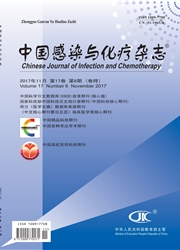

 中文摘要:
中文摘要:
目的分析铜绿假单胞菌临床分离株对亚胺培南耐药机制。方法采用VITEK32系统分析临床菌株耐药性;纸片协同法和纸片扩散法分析金属β内酰胺酶和AmpCB内酰胺酶活性;十二烷基硫酸钠聚丙烯酰胺凝胶电泳(SDS-PAGE)方法分析临床菌株的外膜蛋白OprD的表达;PCR法扩增基因oprD并测序分析;随机扩增多态性DNA标记方法对临床菌株进行分型。结果7株菌确认为亚胺培南中介株,其中2株菌外膜通道蛋白OprD可能存在缺失,进一步分析发现其编码基因被插入序列ISRP10阻断。其余5株菌OprD蛋白大小存在差异,相应编码区大小为427-443个氨基酸,OprD蛋白二级结构转角区域L1-L8处均存在多种氨基酸替代或缺失。结论铜绿假单胞菌被插入序列ISRPIO阻断失能,或其外膜蛋白基因oprD及OprD蛋白二级结构转角区域的氨基酸突变,导致临床分离株对亚胺培南呈中介。
 英文摘要:
英文摘要:
Objective To analyze the mechanism of imipenem resistance in Pseudomonas aeruginosa clinical isolates. Methods Antibiotic resistance was analyzed using VITEK32 system. Metallo β-lactamase activity was determined by double- disc synergy test. Amp C β-lactamase activity was determined by Kirby-Bauer disc method. OprD protein was analyzed by sodium dodecyl sulphate-polyacrylamide gel electrophoresis. PCR was performed to amplify gene oprD. The amplified products were subject to sequencing analysis. The phylogenetic relationship was determined using random amplified polymorphic DNA (RAPD) method. Results Membrane protein OprD was analyzed in 7 clinical isolates of imipenem-intermediate P. aeruginosa. Two strains were devoid of OprD proteins and the corresponding oprD genes were found disrupted by the insertion element ISRP10 in the coding regions. Five strains had OprD proteins with different sizes. Sequence analysis showed that the peptides ranged from 427 to 443 amino acids. Multiple amino acid substitutions and / or deletions were found within the Loop 1 through Loop 8 of the OprD secondary structures. Conclusions ISRPIO inactivation and amino acid substitutions in oprD gene confer imipenem resistance in the clinical isolates ofP. aeruginosa.
 同期刊论文项目
同期刊论文项目
 同项目期刊论文
同项目期刊论文
 期刊信息
期刊信息
